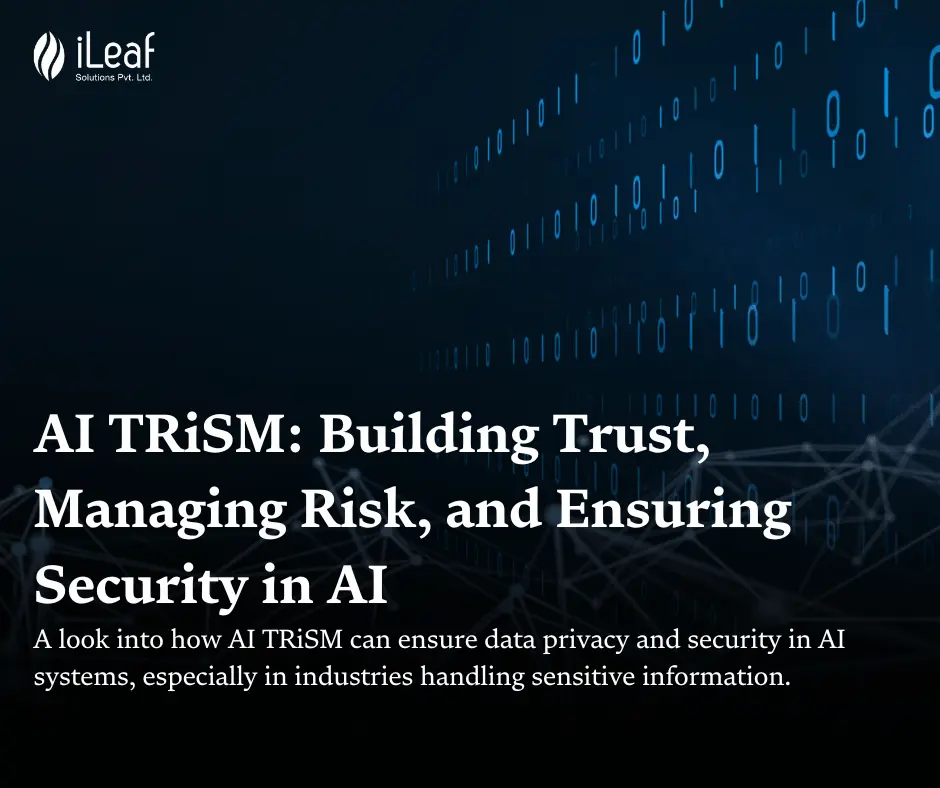AI TRiSM: Building Trust, Managing Risk, and Ensuring Security in AI

Table of Contents
- Introduction
- Components of the AI TRiSM Framework
- Implementing the AI TRiSM Framework in Fintech Organizations
- Benefits of Adopting Explainability Tools for Building Consumer Confidence
- Challenges Faced by Organizations While Striving Towards Ethical Use Of Artificial Intelligence Technologies
- The Future Of Trust In Artificial Intelligence Applications Is Bright With The Help Of Well-Established Frameworks Like Aitrism!
1.Introduction
It thus has become an essential need for businesses, cutting across different industries, in order to establish trust, manage risks, and ensure security in this fast-changing world of artificial intelligence. The financial technology (fintech) sector employs AI-based solutions across all functions that involve decision-making processes, process automation, and a better experience in delivering products to its customers, among others. The raising use of AI-based solutions thus post the need for robust frameworks of its fair, secure, and transparent operation. And it is here that AI TRiSM-a framework for Trust, Risk, and Security Management in AI—comes into play.
In this blog, we'll cover the composition of the AI TRiSM framework; how fintech firms can implement this framework; and what they stand to gain from adopting the same. We also go over the challenges businesses experience while achieving responsible usage of AI and why the future of AI looks bright in light of the adoption of frameworks such as AI TRiSM.
2.Components of the AI TRiSM Framework
The AI TRiSM framework addresses the concern by bridging the upsurge demand for trust, transparency, and security in AI applications. At its heart, AI TRiSM is anchored on four key components:
Trust: ensure that AI systems operate in a manner that is trustworthy to users. It requires transparency regarding how, when, and why AI decision-making occurs, usage of data, and possibilities of biases.
Risk Management: Identifying and assessing all types of risks associated with the deployment of AI systems and mitigating them.
Security: Safe-guards: Strong protections that can deter hostile external threats against the AI model, data, and processes. That entails almost any form of encryption, access controls, cybersecurity measures, and the trade-off between security and functionality.
Explainability: Explainability is the ability to make AI decision-making processes transparent and understandable. Explainability for fintech is an extremely important aspect, mainly about regulatory compliance. Financial institutions should explain how algorithms arrive at certain decisions regarding credit scoring, loan approvals, fraud detection.
Together, these elements provide a comprehensive framework that ensures robust AI-a feature which also becomes dependable, secure, and ethically guided.
Key Features of AI TRiSM:
Continuous Monitoring: Regularly evaluating AI systems to detect anomalies or deviations from expected behavior.
Ethical Audits: Periodic audits to assess the ethical implications of AI usage.
3.Implementing the AI TRiSM Framework in Fintech Organizations
Fintech is in the lead in pioneering the AI trend by providing the use of machine learning algorithms to give personalized services, detect fraudulent transactions, and streamline operations. However, because decisions over finances are inherently complex and high-stake, fintech organizations must ensure that their AI systems are trustworthy, risk-free, and secure.
Steps for Implementation:
Audit Current AI Systems: Identify where transparency, risk management, or security are weak in existing AI applications within your organization.
Explainability Tool Integration. Explainability is one of the foundational building blocks of AI TRiSM. Fintech companies should ensure that explainability tools are integrated in a way that the decision-making mechanisms of the AI seem clear to the user as well as the regulators and stakeholders. For example, why did certain factors get a higher or lower score on my credit scoring algorithm?.
Develop ethical standards: An organization should develop and enforce usage guidelines regarding the ethical use of AI; this would include data usage, fairness, bias mitigation and customers' privacy.
Implement Continuous Monitoring: AI Models within Fintech Are Non-Static: While the AI models themselves within fintech are not static, they do continually evolve based on new data fed into them. Systems for continuous monitoring of AI models have to be implemented so that these models do not stray away from the organization's risk management and security policies.
Training of employees, all levels, should understand the AI TRiSM framework and are inculcated with it within their line of duties. The training would include AI ethics, data privacy workshops, as well as courses in AI risk management.
4.Benefits of Adopting Explainability Tools for Building Consumer Confidence
Explainability is one of the most crucial elements of AI TRiSM, especially for fintech companies that deal with sensitive customer data. Consumers want to know how their personal and financial information is being used and how AI systems are making decisions that impact their lives.
Why Explainability Matters:
Increased Trust: When fintech companies are transparent about how their AI systems work, customers are more likely to trust them. For example, if a customer is denied a loan, explaining the factors behind the decision can foster understanding rather than frustration.
Regulatory Compliance: Many countries are introducing AI regulations that require companies to explain their algorithms’ decision-making processes. Implementing explainability tools helps organizations stay compliant with laws such as the EU’s General Data Protection Regulation (GDPR).
Improved Customer Experience: Transparent AI systems improve customer experiences by offering clear, understandable outcomes. For example, an AI-powered financial planning tool that explains its recommendations based on a user’s spending habits and future goals will be seen as more reliable and valuable.
Tools and Techniques for Explainability:
LIME denotes a method called Local Interpretable Model-Agnostic Explanations. It is the most widely used technique to explain the predictions made by AI models.
SHAP (Shapley Additive Explanations): Another well-known method that enhances the interpretability of machine learning models by explaining how much each feature contributes.
5.Challenges Faced by Organizations While Striving Toward Ethical Use of Artificial Intelligence Technologies
Even though there are myriad benefits in frameworks like AI TRiSM, the job of implementing these frameworks is far from easy for the organizations. Organizations face a lot of hurdles while striving towards the ethical usage of AI.
Bias in Data: This happens to be one of the biggest hurdles that needs to be addressed. If the AI model is trained on biased data then, its decision will also reflect that bias and the outcome will not be fair.
Lack of AI Skills and Expertise: The biggest challenge that most organizations would face is the lack of human talent available to support the effective implementation and management of AI TRiSM frameworks.
Static Tension between Innovation and Regulation: Innovations in Fintech companies have to come in quickly, while the new AI applications are delayed by emerging AI regulations, which causes static tension between innovation and regulation.
Cost and Resources: Fully-fledged AI TRiSM framework will have significant investment in technology, training, and resources. Smaller fintech firms find it difficult to match a reasonable budget for such initiatives.
Continuous Monitoring: AI systems are not static; they change with time as they learn from new data. Continuous monitoring of these systems to ensure they stay within the ethical and compliant bounds can be resource-hungry.
6.The Future of Trust in Artificial Intelligence Applications is Bright with Well-Established Frameworks like AI TRiSM
Frameworks like AI TRiSM provide a robust solution for managing trust, risk, and security, ensuring that AI applications are not only powerful but also ethical and transparent.
What’s Next for AI TRiSM?
Wider Adoption: As regulators continue to tighten the noose around the fintech industry, more organizations will look towards incorporating AI TRiSM frameworks in order to be compliant and competitive.
Improved explainability: Advances in explainability tools will bring it to where it is a whole lot easier for companies to explain just what the AI model is doing, all of which helps improve trust and transparency.
Evolving standards are the AI technologies. With evolution, frameworks such as AI TRiSM would be revised and new ethical considerations and security challenges attached to it.
By embracing AI TRiSM, fintech firms will be able to make sure their innovations in AI will serve consumers better while ensuring they do this in a manner that is secure, fair, and trusted by both the consumers and the regulators.














